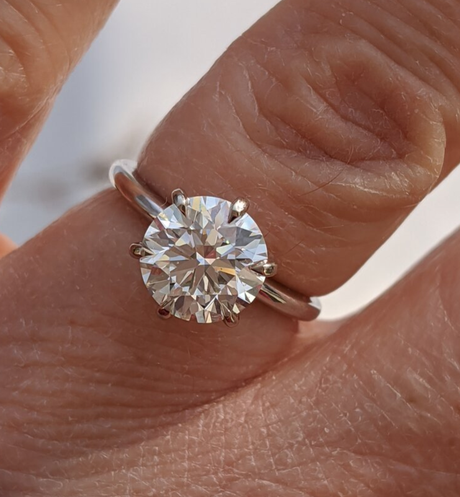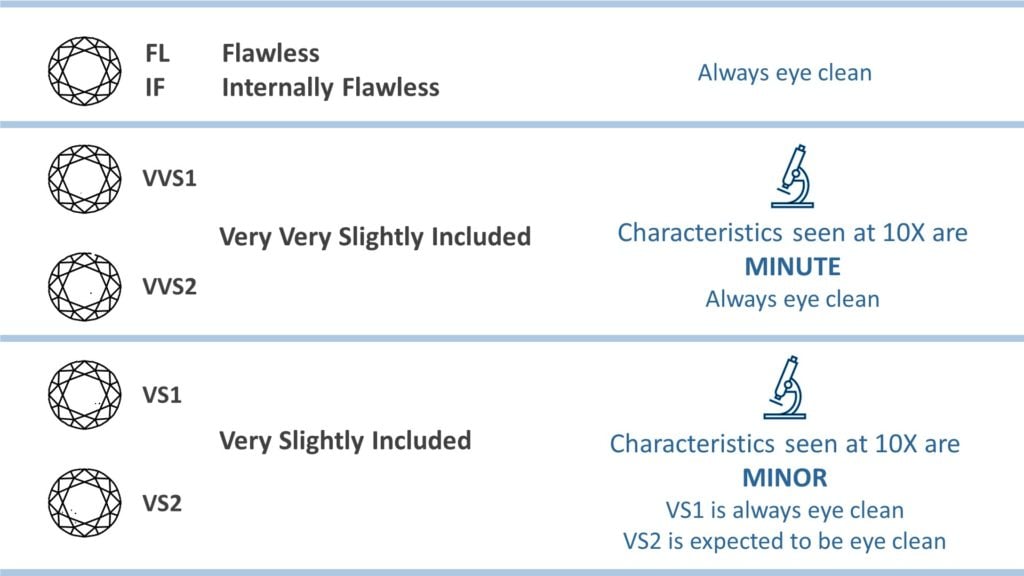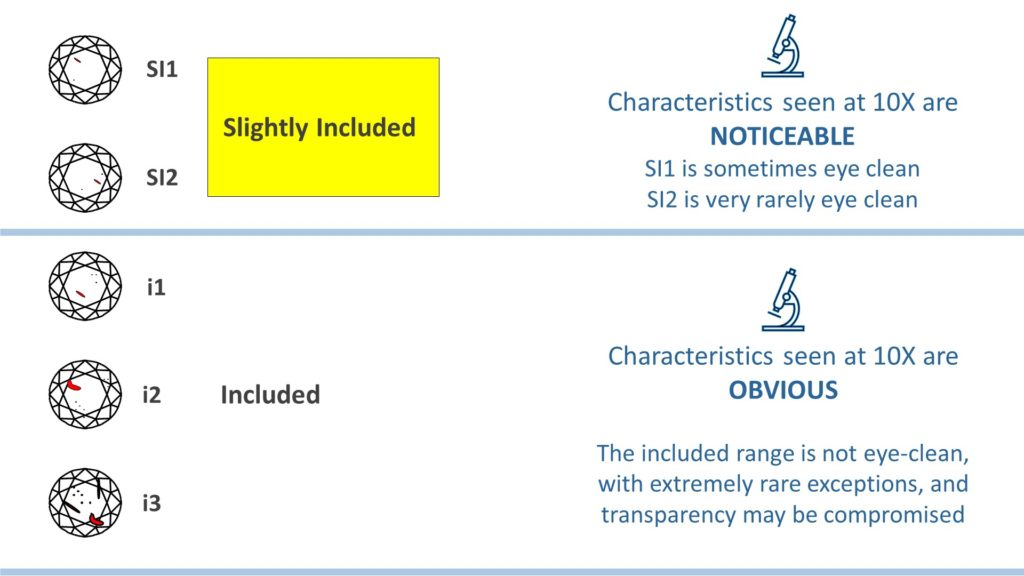How Are Diamonds Made? Natural vs Lab-Created Explained
Two Paths, One Diamond Not all diamonds come from the same place — but they all start the same way. Pure carbon, crystalized under immense pressure and heat. Whether it…
SI Diamond – Basics
SI diamond clarity is divided into levels SI1 and SI2. Diamonds with these grades may have visible inclusions, but there are exceptions which are perfectly clean to the naked eye. Here is useful information when considering the purchase of a diamond with an SI1 or SI2 clarity grade.
PriceScope Pointer: If you’re seeking an SI diamond with no visible inclusions, be sure you have a clear definition for “eye clean” like the one we will provide below.
Before going on: Check out the PriceScope Diamond Buying Guide
The diamond clarity grade describes a stone’s relative freedom from internal characteristics, classified as inclusions, and surface characteristics, classified as blemishes.
“SI” stands for “slightly included” and refers to diamonds with inclusions which are noticeable to a gemologist when using 10X magnification. The SI diamond clarity range spans two levels. An SI1 diamond has less significant or noticeable clarity characteristics than an SI2 diamond.
While the most typical inclusions are crystals, clouds, and feathers, an SI diamond may have any natural inclusion or blemish. Inclusions under the table typically become obvious at 10X magnification. If the grade setting inclusion or inclusions are close to the very slightly included (VS) range the diamond will receive the SI1 grade. If the inclusion or inclusions are closer to the included (I) range the diamond will become SI2.
Wondering which of the many diamond colors is best for you? Our elite list of vetted vendors like Whiteflash and James Allen are experts at listening and helping you determine which combo of the 4Cs is perfect for you - and nicely in budget. Contact Us and get help today.
Because the gemologist sets the grade using 10X magnification an SI diamond may or may not have inclusions which are visible to the naked eye. A fair number of diamonds graded SI1 have no visible characteristics in the face-up view. Eye visible inclusions are far more frequent in diamonds graded SI2. Since most people just want an “eye-clean” diamond, meaning one which has no inclusions invisible to the naked eye, this can present an opportunity for bargain hunters.
There is no laboratory definition for eye-clean, but a PriceScope survey of gemologists resulted in this consensus:

Photo Courtesy of PS Member Soxfan
Eye-clean = No inclusions visible to the unaided eye when viewed from the face up position in daylight equivalent or fluorescent lighting from approximately 6 – 12 inches from the eye using 20/20 vision.
Any SI diamond needs to be considered on its own merits. Prior to online purchase, it’s important to have a clear understanding of the wearer’s eye clean standards and to communicate those standards with the seller. No photo or video can communicate whether a diamond is eye clean. Depending on focal depth, exposure and other settings a photo or video may not reveal some eye-visible inclusions. Alternately, some imaging will make a diamond’s inclusions or blemishes seem far worse than they are.
An eye visible inclusion in an SI diamond may not be a deal-breaker. If the characteristic is near the girdle it may be “prongable” meaning a prong could be used to reduce or eliminate its visibility in the face up position.
If an SI diamond seems inexplicably low priced it may have undisclosed clarity issues related to haziness (clouds) beyond 10X magnification which impact its transparency. Trade members refer to such diamonds as “sleepy” stones, a phenomenon which occurs on a sliding scale. Before jumping on a deal which seems too good to be true, familiarize yourself with the nature of these undisclosed clarity issues.
PriceScope’s 1-5 star ratings are categorical comparisons with the most thorough, consumer-focused online diamond and jewelry vendors, in categories, we believe reflect our experienced consumer community’s values. Check out PriceScope Jeweler Reviews.
The internationally accepted grading scale and terminology for diamond clarity consist of 11 grading levels. Grading is traditionally performed using 10 power (10X) magnification. An SI diamond falls into the “slightly included” range, atop the bottom five grades.


A clarity grader will also consider the location, number, color, size, and nature of the characteristics present at 10x magnification when deciding the clarity grade.
If you’re looking to buy loose diamonds online, use our special tools to reveal the best cut quality diamonds! Start your diamond search and choose from over a million loose diamonds for sale. Use our filters to find either natural or lab diamonds, as well as fancy color diamonds.
While the descriptive scale above is universally applied, standards can vary between individuals and organizations that decide on I1 diamond clarity.
Variance between reputable graders and organizations may be attributable to standard deviation. Color and clarity judgments are matters of opinion and diamonds often sit on the border of two grades. The only time this becomes an issue is when a buyer and seller disagree about which set of grades establish the diamond’s value.
Intentional over grading has been a historic issue in the diamond trade. Over grading is a willingness to purposely deviate from internationally accepted standards to inflate the perceived value of a diamond. Certain locations of the EGL (now closed) became infamous for over-grading loose diamonds, by 3-4 grades in some cases, permitting unscrupulous sellers to overcharge consumers.
Under grading occurs when a jeweler examines a diamond and claims it was over graded to create fear-based doubts in the diamond owner’s mind. The most frequent example of under grading is when one jeweler implies a consumer overpaid a competing jeweler, hoping the consumer will return the diamond and purchase there, instead.
Get quick answers to any question now: Ask our community of unbiased independent helpers.

Retail Diamond Prices Chart Updated Monthly.

Two Paths, One Diamond Not all diamonds come from the same place — but they all start the same way. Pure carbon, crystalized under immense pressure and heat. Whether it…
A Wedding Ring as Unique as Your Love Finding the right wedding ring isn’t just about diamonds or gold – it’s about finding the one that feels right. With hundreds…
So, you’re thinking about lab-grown diamonds? Smart move. They’re just as sparkly as the natural kind but usually cost less. But where do you actually go to buy them? It…

Want to stay updated on the most recent blogs, forum posts, and educational articles? Sign up for Bling News, PriceScope’s weekly newsletter.